
What a year it’s been for the advertising world. We saw economic decline, countless businesses close, and marketing budgets cut in half. According to Statista, global media spending is projected to amount to $691.7 billion U.S. in 2020, some $20 billion less than previously expected for this year. More specifically, according to the OAAA, Out-of-Home (OOH) advertising revenue decreased by 36% in the third quarter of 2020 compared to the previous year – including truck-side advertising. Needless to say, it’s been a rough year for everyone, and we can’t wait for it to be over. In the meantime, let’s take a look at some of the parts of 2020 that were positive for the advertising world, in particular truck-side advertising, and celebrate what makes the medium an incredibly fast-paced and adaptable one – even in the most difficult of times.
It’s no surprise why the OOH advertising industry was struck so hard by the pandemic. Mass quarantines, social distancing guidelines, cancelled events, and an overall decrease in foot traffic, forced advertisers to adjust the way they market to consumers. In doing so, two major shifts in the industry occured. One was the huge increase in Digital OOH (DOOH) spend, which is expected to reach $2.72 billion and account for 33% of all U.S. OOH ad spend for the year. Despite the pandemic being a large factor in the shift in ad spend to DOOH, this is a medium that has been on the rise for several years now. DOOH has become more widespread, innovative, and capable due to the advancements in technology. This is especially true when considering truck-side ads that have become digitally programmed. In recent years, not only have advertisers been able to create truck-side ads that are digitally driven using LED lights and moving screens, they’ve also become digitally connected, tracking consumer data and pinpointing prime engagement locations.
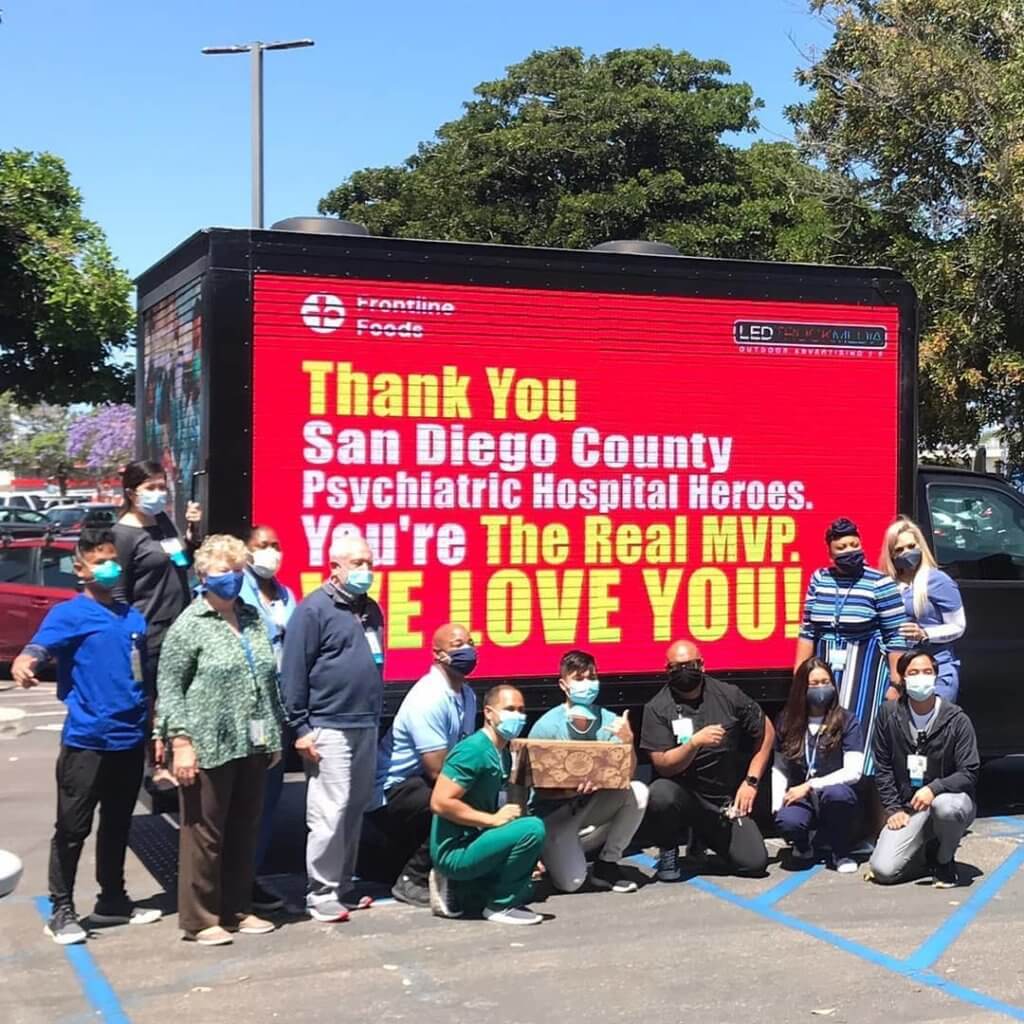
One of the most inspiring and charitable truck-side campaigns was created this year by LED Truck Media in collaboration with iHeartRadio in San Diego. The two companies teamed up to aid small businesses with free exposure on LED Truck Media’s digital billboard trucks. The LED truck company rolled out a few LED trucks with signs that read encouraging and grateful messages like, “Thank You San Diego County Psychiatric Hospital Heroes. You’re the real MVP. We love you!”. The trucks roamed around the streets of San Diego, demonstrating to all passersby just how important health care workers have been this year. Other trucks displayed various advertisements for local businesses, encouraging consumers to shop there. The hosts of iHeartRadio joined in on the promotional content by soliciting businesses to participate in the advertising program on-air and on their website. This campaign was not only locally appreciated and regarded, but also set an example for advertising companies across the country to join the fight for keeping small businesses open and thank those that are saving lives during the pandemic.
PSA campaigns of the year
Speaking of the pandemic, many advertisers and brands decided to share their support and their admiration for healthcare workers across the globe this year as the pandemic raged on. Although some companies did receive backlash for pandering to their audiences by using the pandemic to further their own interests, a lot of ads were created to inform and unite us all as we attempt to remain healthy and hopeful for the vaccine.
The World Health Organization alongside the United Nations created a health and safety awareness campaign to inform viewers and create awareness about ways to stay healthy during the pandemic. The campaign is currently running messaging on OOH and online digital display media across the United States, Canada, Mexico, Brazil, Argentina, Italy, and the UK. The truck-side ads that have been deployed offer a number to text that could answer any questions that people may have about the pandemic and ways to reduce the spread of the virus. This was a massive production, especially considering the organizations involved are debatably the most trusted and important in the world.
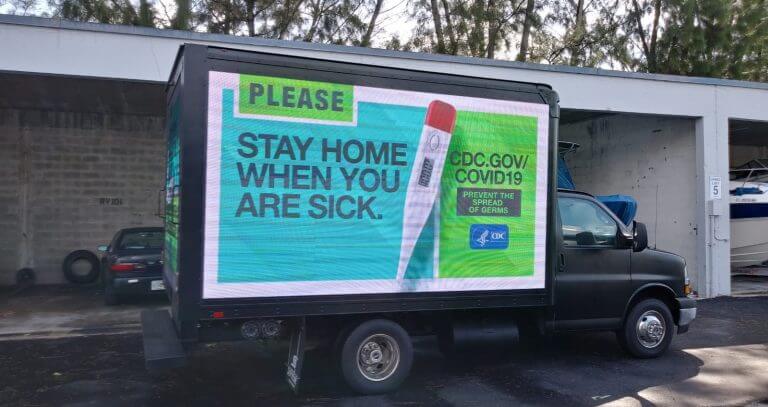
Another extremely important truck-side campaign that took place this year was conducted by the Outdoor Advertising Association of America (OAAA) in partnership with the Centers for Disease Control and Prevention (CDC). Thousands of digital OOH units across America were deployed asking Americans to be as diligent as possible in washing their hands, staying home if they have any Covid symptoms, and to avoid touching their eyes, nose, and mouth. Together alongside the CDC, the OOH industry wants to help in supporting public-information goals set by health professionals to keep everyone as safe as possible.
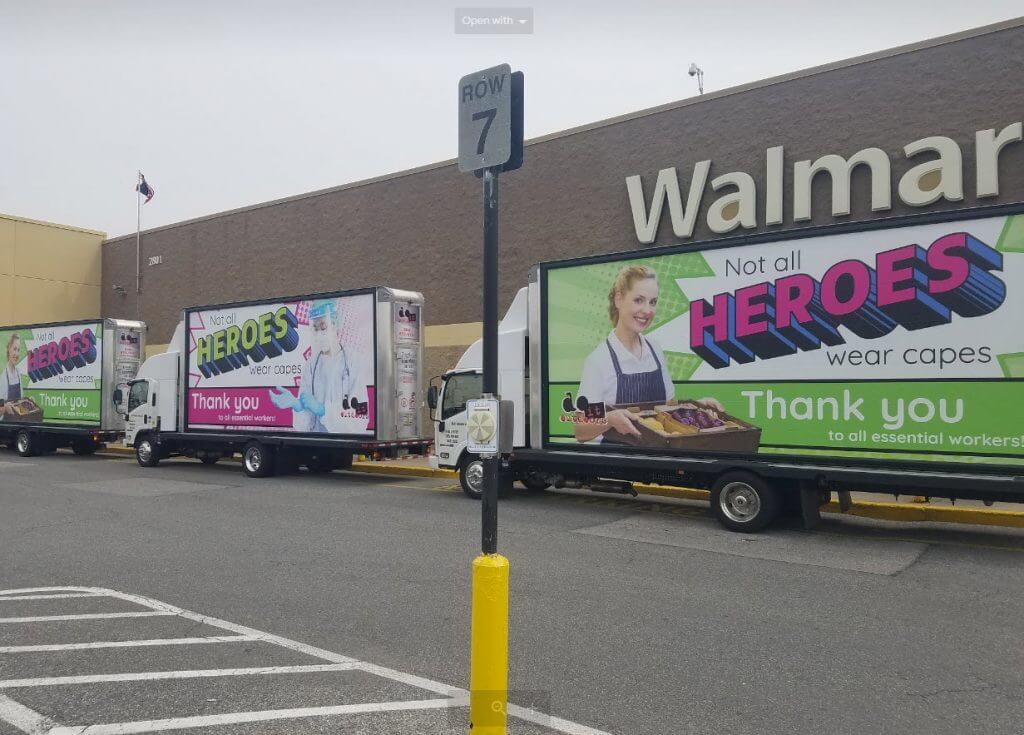
Do It Outdoors Media, a large player in the OOH media space, decided to join in on the pandemic PSA movement. They began running three of their largest mobile billboard units out on the road that displayed thank you messages as well as messages that read, “Not all heroes wear capes”, targeting essential grocery stores and healthcare workers. The routes were strategic in hitting each and every grocery store, hospital, health clinic, and pharmacy in the York region at least once, encouraging the local heroes to check out the messaging from their buildings. The campaign was a huge success in raising awareness about the pandemic as well as encouraging and thanking the health care workers that have made the pandemic somewhat bearable.
Election campaign advertising galore!
Another massive phenomenon that took place this year was the United States Presidential election that caused countries all over the world to take notice and tune in. As people everywhere became captivated with the electoral campaigns, so too did advertisers, taking advantage of the coverage the ads would surely receive.
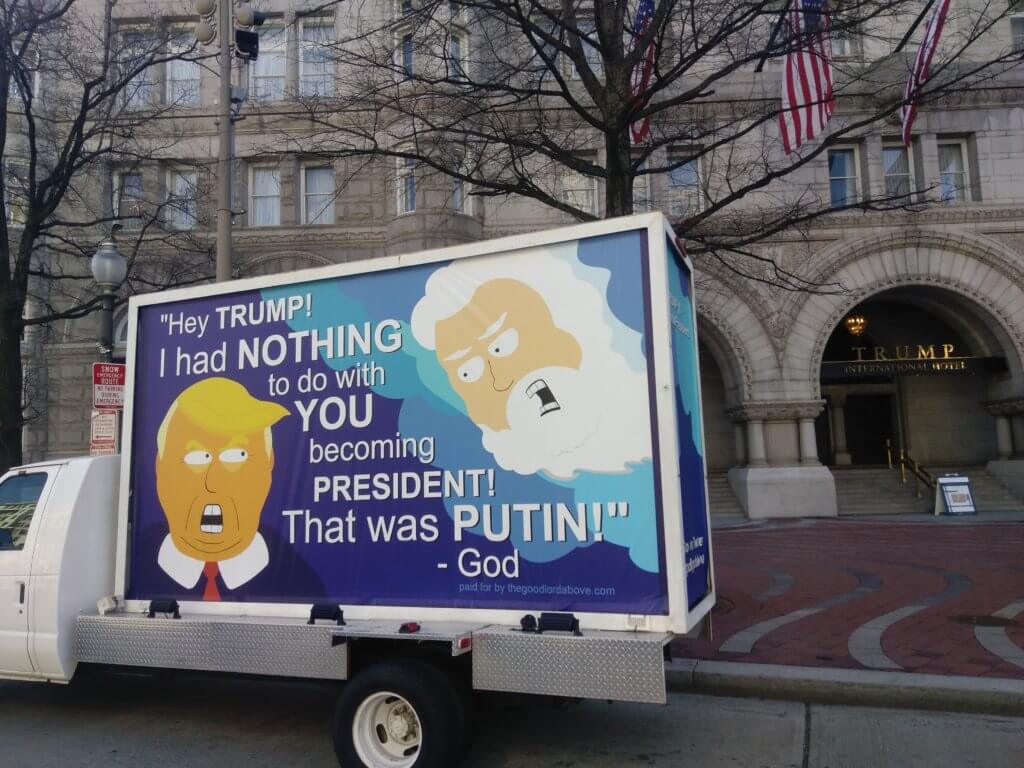
DC Mobile Ads recently created a political campaign in Washington to create buzz around the upcoming election. The campaign targeted locations such as monuments, museums where tourists flock, government buildings that employ federal workers and elected officials, as well as the downtown core during the lunch rush to target the general public. The message featured a cartoon image and somewhat humorous copy that read, “‘Hey Trump! I had nothing to do with you becoming president! That was Putin!’ – God”. The truck-side ad generated a huge crowd of reporters at the U.S. Federal Courthouse where the sentencing of Trump’s associate, Paul Manafort, was being covered. The ad then went viral, being displayed on major television outlets like CNN. Although humorous in the creative sense, the message was very clear and very well-timed in order to demonstrate to viewers the mockery that President Trump has subjected himself to.
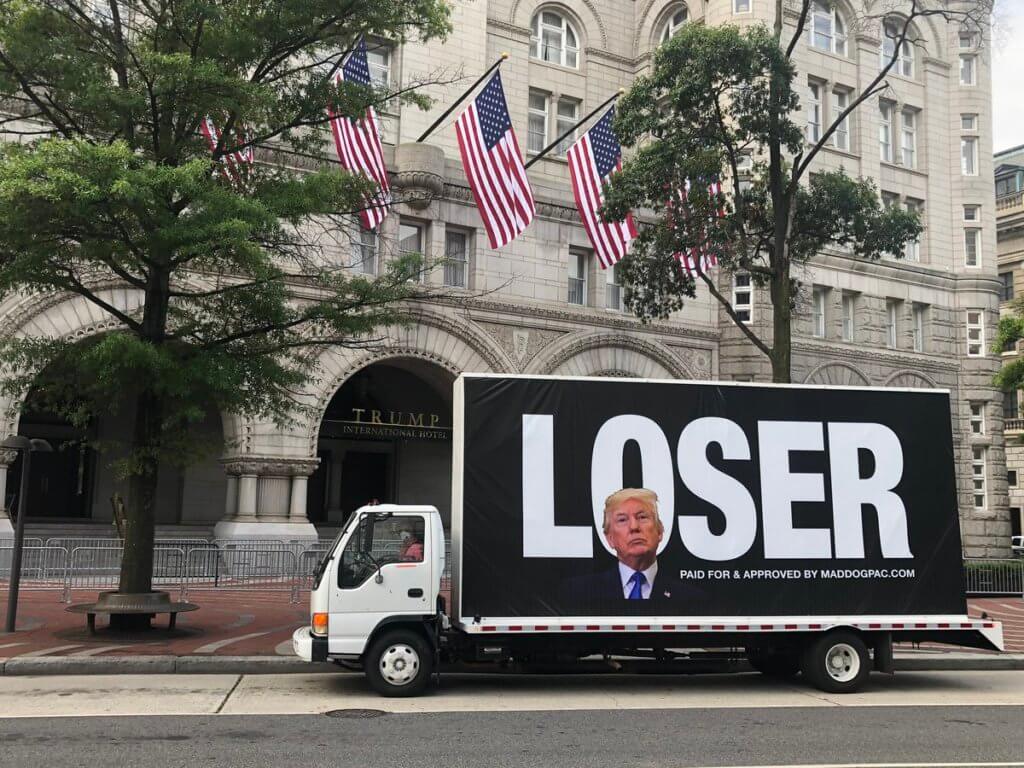
In the same vein, an anti-Trump political action committee by the name of Mad Dog PAC, sent a billboard truck bearing the president’s face and the word “LOSER” to the White House on November 6th of this year. This campaign took place as election votes continued to be counted across the country. The truck-side ad, along with many others by Mad Dog PAC, went viral on the internet including social media outlets like Twitter and Instagram for its blunt and highly targeted messaging. There’s no denying who this advertisement targeted and why it was deployed. This campaign demonstrates the ability of advertisers to create of-the-moment campaigns with relative ease and cost effectiveness.
Creativity at its finest
This year has allowed truck-side advertisers to stay inside and think at great lengths about how to implement creative advertisements. This is especially true when considering that for most of the year people were stuck indoors, unable to view OOH ads. Advertisers had to be particularly creative in catching the eyes of consumers, whether they were walking down the street, in their cars, or in their homes. Let’s take a look at some of the truck-side ads that were successful in allowing imagination, creativity, and joy to exist in a year full of doom and gloom.
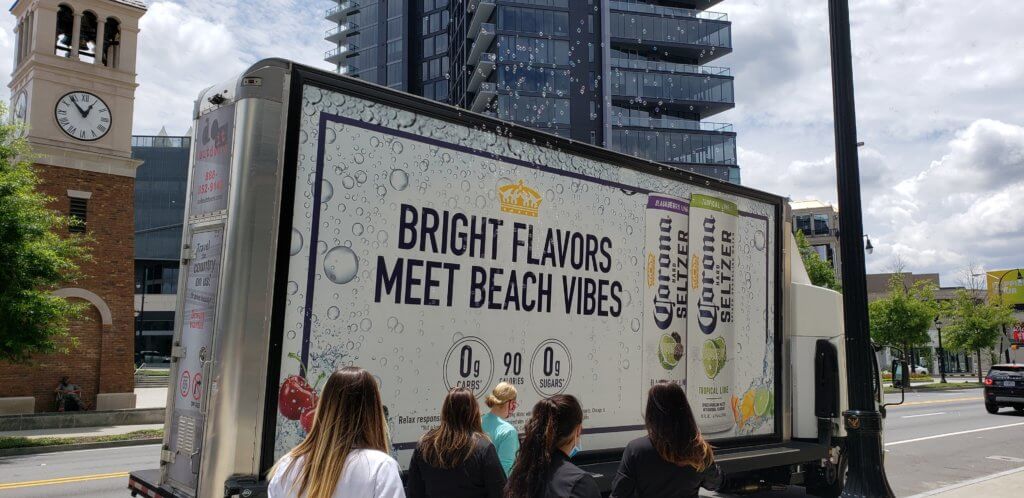
Do It Outdoors ran an ad campaign for Corona Seltzer this past summer that blew the roof off creativity within the medium this year. Not only was the ad extremely bright, fun, texturized, and thirst-quenching, it also included real-life bubbles. Do It Outdoors modified the truck to include a bubble machine to make it appear as though the seltzers on the truck were creating real-life bubbles. The truck-side ad campaign was a smash hit, creating quite the buzz both on the streets and online. Adding that extra something to a campaign really can make all the difference and increase engagement ten-fold.
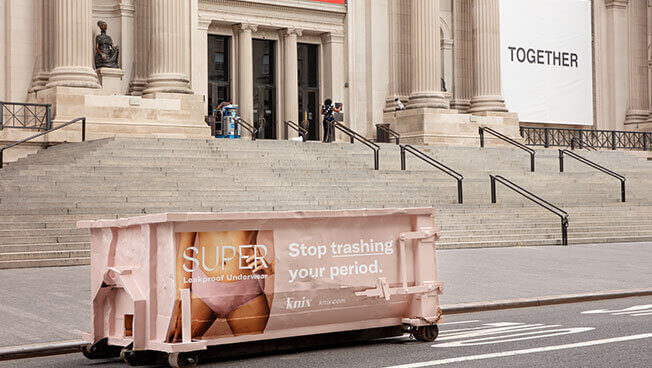
Knix, a Toronto-based intimates’ brand, teamed up with Movia to create a customized dumpster truck with a vinyl wrap that called on women to “stop trashing their periods.”. The truck toured around popular spots in NYC such as Times Square, Grand Central Terminal, and Brooklyn Bridge. The OOH ad used the garbage truck as a larger-than-life metaphor for female hygiene waste, staying on top of the environmentally conscious consumer trend. The campaign was paired with a 30-second national TV commercial and promoted it on all major social media channels, including Twitter and Instagram. With the help of Movia, Knix was able to create an extremely unique and unforgettable campaign that exploded online and surpassed all KPI expectations, demonstrating the creativeness of truck-side advertising and the out-of-the-box thinking done by Movia.
The importance of place-based advertising
A few very fascinating truck-side advertisements were created this year in order to showcase the importance of being at the right place at the right time as well as the exceptional way that truck-side advertising is able to make that possible.

The Matte Project along with Monogram Company, Jay-Z’s very own Cannabis company, wanted to send 2 different messages through OOH advertising. They parked 2 different truck-side advertisements at the border crossings of ten states that have opposing laws regarding marijuana usage, with each side of the mobile billboard facing the state in which marijuana is legal or illegal. The point of the campaign was to showcase the legality surrounding cannabis in the United States and at the same time, showcase Monogram as a responsible and approved place that consumers can buy their cannabis from.
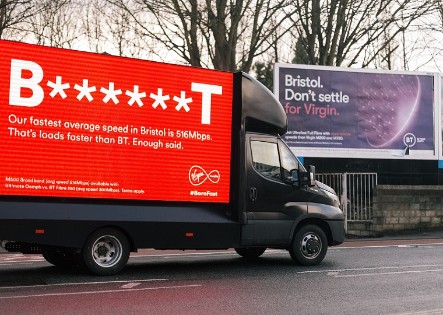
This past year, Virgin Media and competitive telecom provider BT, used OOH advertising to begin a broadband war against each other in the name of comparative advertising. To check out the full story, follow this link. BT erected an OOH billboard that poked fun at Virgin Media’s 300,000 customers in Bristol with the message, “Bristol. Don’t settle for Virgin”, appealing to local residents. In response to this confrontational billboard, Virgin Media created a mobile billboard that read, “B******T. Our fastest average speed in Bristol is 516Mbps. That’s loads faster than BT. Enough said.”. The response was perfect in shutting BT down as well as sparking worldwide engagement and awareness as the battle between the two went viral online.
To conclude
As this year comes to a close, it becomes apparent from the examples above, along with many others that were not mentioned, that the truck-side advertising industry did exactly what it should have done to stoke hope, excitement, engagement, creativity, and gratitude during a pandemic that offered none of these things. As we look to the future of advertising, we will continue to see truck-side advertisements flourish in this way. It is a medium that’s able to transcend the boundaries of its industry and adapt to whatever the future may hold. It will be interesting to see how advertisers create new truck-side ads in the coming years, and I for one, can’t wait to see what the medium has in store.


